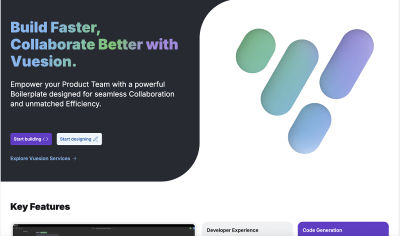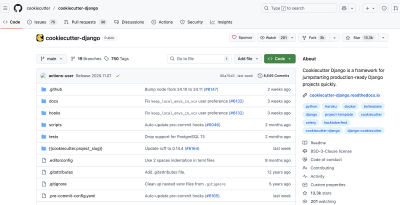Boilerplates & Starters
Auth, DB, UI, DX presets.
Showing 2 of 2 apps

Vuesion
Vuesion is a full-stack Nuxt and Vue boilerplate with a built-in design system, authentication, PWA, i18n, and robust testing so product teams can ship modern web apps faster with best practices baked in.
by

Cookiecutter Django
Cookiecutter Django
by
Boilerplates and starter kits provide pre-configured project foundations with essential features like authentication, database integration, and UI components already implemented. The best solutions combine modern tech stacks with excellent developer experience to eliminate repetitive setup work and accelerate development.
Popular examples
- Next.js Boilerplate — Full-stack React application with authentication, database, payments, and deployment ready
- tRPC starter — Type-safe API development with React, TypeScript, and end-to-end type safety
- SaaS starter kit — Complete SaaS foundation with user management, billing, and admin dashboard
Who uses boilerplates and starters?
- Indie developers launching MVPs and side projects quickly without reinventing common features
- Startups accelerating time-to-market with proven technical foundations
- Agencies standardizing project setup and reducing client onboarding time
- Enterprise teams establishing consistent architecture patterns across projects
- Learning developers studying best practices and modern development patterns
Key features to evaluate
- Tech stack modernity: Current versions of frameworks, libraries, and development tools
- Feature completeness: Authentication, database, UI, testing, and deployment setup
- Code quality: TypeScript support, linting, formatting, and architectural patterns
- Documentation quality: Setup guides, customization instructions, and deployment help
- Maintenance activity: Regular updates, security patches, and community engagement
- Customization ease: Ability to modify, extend, and adapt to specific requirements
- Performance optimization: Built-in best practices for speed, SEO, and user experience
Essential boilerplate components
Authentication and user management:
- Multiple auth providers: Email/password, social logins (Google, GitHub, Twitter)
- User roles and permissions: Admin, user, and custom role management
- Session management: Secure token handling and refresh mechanisms
- Profile management: User settings, avatar upload, and account preferences
Database and data layer:
- ORM integration: Prisma, Drizzle, or TypeORM with type safety
- Database migrations: Version control for schema changes
- Seed data: Sample data for development and testing
- Connection pooling: Optimized database performance and scaling
UI and styling foundation:
- Component library: Tailwind CSS, shadcn/ui, or custom design system
- Responsive design: Mobile-first layouts and breakpoint management
- Dark mode support: Theme switching and preference persistence
- Accessibility: WCAG compliance and screen reader support
Modern tech stack combinations
React ecosystem starters:
- Next.js 14+: App router, server components, and streaming
- Remix: Full-stack React with nested routing and data loading
- Vite + React: Fast development with modern build tooling
- T3 Stack: Next.js, TypeScript, tRPC, Prisma, and Tailwind CSS
Backend and API patterns:
- tRPC: End-to-end type safety with TypeScript APIs
- GraphQL: Apollo Server/Client or Relay for flexible data fetching
- REST APIs: Express, Fastify, or Next.js API routes
- Serverless: Vercel Functions, Netlify Functions, or AWS Lambda
Database and storage:
- PostgreSQL: Robust relational database with JSON support
- SQLite: Lightweight option with Turso for edge deployment
- MongoDB: Document database with Mongoose ODM
- Supabase: PostgreSQL with real-time features and authentication
Developer experience optimizations
Development workflow:
- Hot reload: Instant feedback during development
- TypeScript configuration: Strict typing with helpful compiler options
- ESLint and Prettier: Code quality and consistent formatting
- Husky and lint-staged: Pre-commit hooks for quality assurance
Build and deployment:
- Optimized bundling: Code splitting and tree shaking
- Environment management: Development, staging, and production configs
- Docker support: Containerization for consistent deployment
- CI/CD pipelines: GitHub Actions, GitLab CI, or similar automation
Testing and quality assurance
Testing frameworks:
- Unit testing: Jest, Vitest, or similar test runners
- Integration testing: React Testing Library for component testing
- E2E testing: Playwright, Cypress, or Puppeteer for full workflows
- API testing: Supertest or similar for backend endpoint validation
Code quality tools:
- Static analysis: ESLint rules for catching common issues
- Type checking: TypeScript strict mode and custom type definitions
- Security scanning: Automated vulnerability detection
- Performance monitoring: Lighthouse CI and Core Web Vitals tracking
Deployment and hosting configurations
Platform integrations:
- Vercel: Optimized for Next.js with automatic deployments
- Netlify: JAMstack hosting with serverless functions
- Railway: Full-stack deployment with database hosting
- AWS/GCP/Azure: Enterprise cloud deployment configurations
Infrastructure as code:
- Docker configurations: Multi-stage builds and production optimization
- Kubernetes manifests: Container orchestration for scalable deployment
- Terraform modules: Infrastructure provisioning and management
- Environment variables: Secure configuration management
Customization and extensibility
Modular architecture:
- Feature flags: Enable/disable functionality based on requirements
- Plugin systems: Easy integration of additional services and tools
- Theme customization: Brand colors, fonts, and component styling
- Configuration files: Centralized settings for easy modification
Integration readiness:
- Payment processing: Stripe, PayPal, or other payment provider setup
- Email services: SendGrid, Mailgun, or Resend integration
- Analytics: Google Analytics, Mixpanel, or custom tracking
- Monitoring: Sentry, LogRocket, or similar error tracking
Documentation and learning resources
Getting started guides:
- Quick start: Minimal steps to run the project locally
- Detailed setup: Comprehensive installation and configuration
- Deployment guides: Step-by-step hosting and production setup
- Troubleshooting: Common issues and resolution steps
Architecture documentation:
- Project structure: File organization and naming conventions
- Data flow: How data moves through the application
- API documentation: Endpoint descriptions and usage examples
- Component library: UI component usage and customization
Community and maintenance
Open source best practices:
- Clear contribution guidelines: How to submit issues and pull requests
- Regular releases: Scheduled updates with changelog documentation
- Community support: Discord, Slack, or forum for user assistance
- Sponsor programs: Sustainable funding for ongoing maintenance
Version management:
- Semantic versioning: Clear version numbering and compatibility
- Migration guides: Help users upgrade between major versions
- LTS versions: Long-term support for stable production use
- Branch strategies: Separate branches for different tech stack variants
Performance and optimization
Built-in optimizations:
- Image optimization: Next.js Image component or similar solutions
- Code splitting: Automatic route-based and component-based splitting
- Caching strategies: Static generation, ISR, and API response caching
- Bundle analysis: Tools to monitor and optimize bundle size
SEO and accessibility:
- Meta tag management: Dynamic SEO optimization
- Structured data: Schema.org markup for rich snippets
- Sitemap generation: Automatic XML sitemap creation
- Accessibility testing: Automated a11y checks and guidelines
Monetization and business models
Commercial starters:
- One-time purchase: Premium boilerplates with advanced features
- Subscription access: Regular updates and new starter variations
- Custom development: Tailored boilerplates for specific requirements
- Support services: Professional setup and customization assistance
Open source sustainability:
- Sponsorship programs: GitHub Sponsors, Open Collective funding
- Premium add-ons: Commercial extensions to free base templates
- Consulting services: Professional services around open source tools
- Training materials: Courses and tutorials for monetization
Related categories
- APIs & SDKs — Services and libraries commonly integrated into boilerplates
- Code Quality — Tools for maintaining code standards in starter projects
- Testing — Testing frameworks and utilities included in boilerplates
- SaaS Tools — Business applications that benefit from rapid development
Tip: Successful boilerplates focus on eliminating repetitive setup work while maintaining flexibility for customization. Prioritize modern, well-supported technologies and provide excellent documentation for smooth developer onboarding.
Key Features
- Pre-configured authentication systems
- Database setup and ORM integration
- UI component libraries and styling
- Developer experience optimizations
- API routes and backend structure
- Deployment and hosting configurations
- Testing frameworks and CI/CD setup
- Documentation and development guides
Frequently Asked Questions
What should be included in a modern web application boilerplate?
Authentication, database integration, UI components, TypeScript setup, testing framework, deployment configuration, and comprehensive documentation. Focus on commonly needed features that save significant setup time.
How do I choose between different boilerplate options?
Consider your tech stack preferences, project requirements, maintenance activity, community size, and customization needs. Evaluate the quality of documentation and ease of getting started.
Should boilerplates be opinionated or flexible?
Balance is key. Provide sensible defaults for quick starts while allowing easy customization. Include popular, well-supported technologies but make swapping components straightforward.
How do I keep boilerplates up-to-date with evolving technologies?
Regular maintenance schedules, automated dependency updates, community contributions, and version branches for different tech stack combinations. Monitor ecosystem changes and user feedback.
What's the difference between boilerplates, templates, and starters?
Boilerplates are comprehensive project foundations, templates are lighter starting points, and starters often include specific integrations. All aim to reduce initial development time.